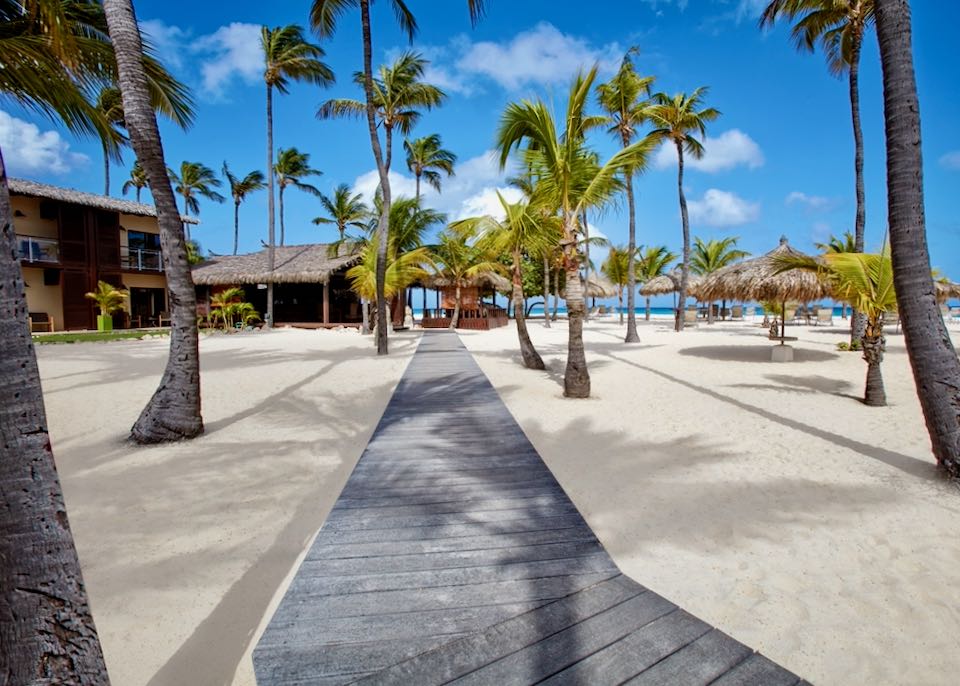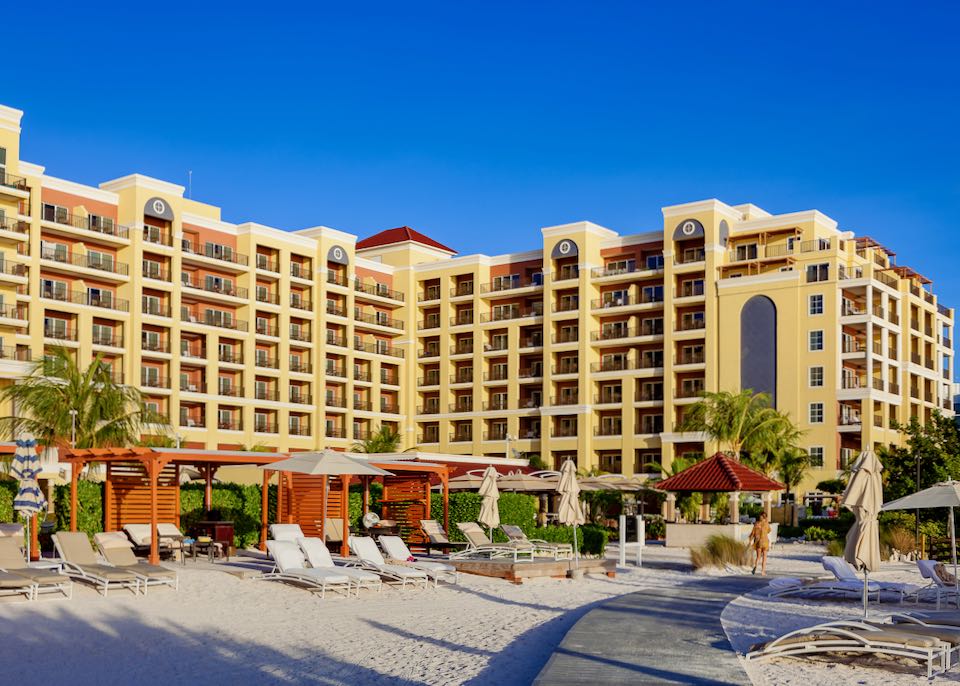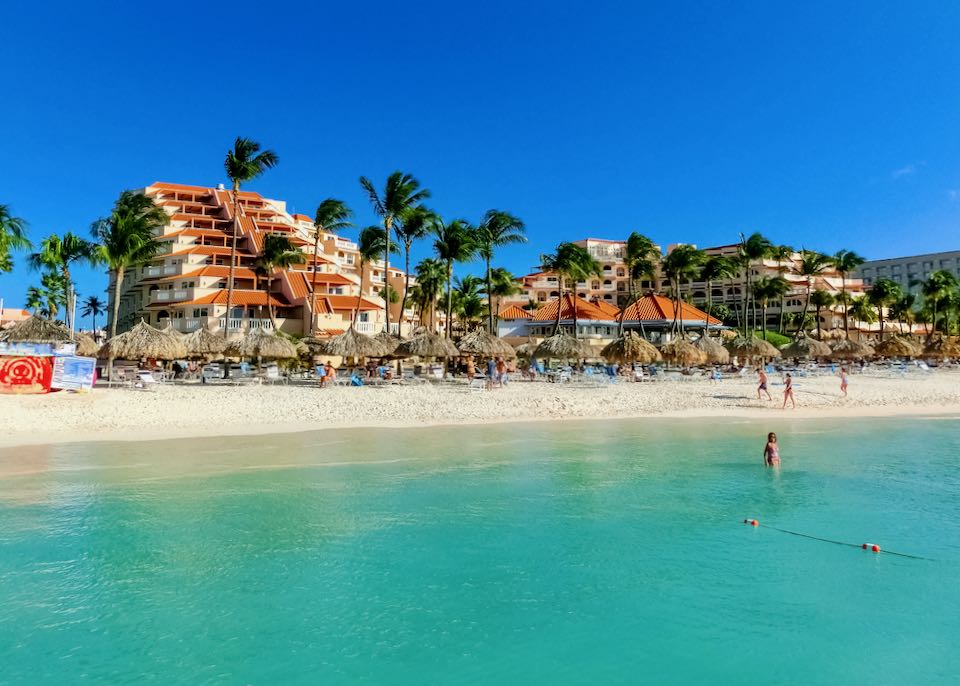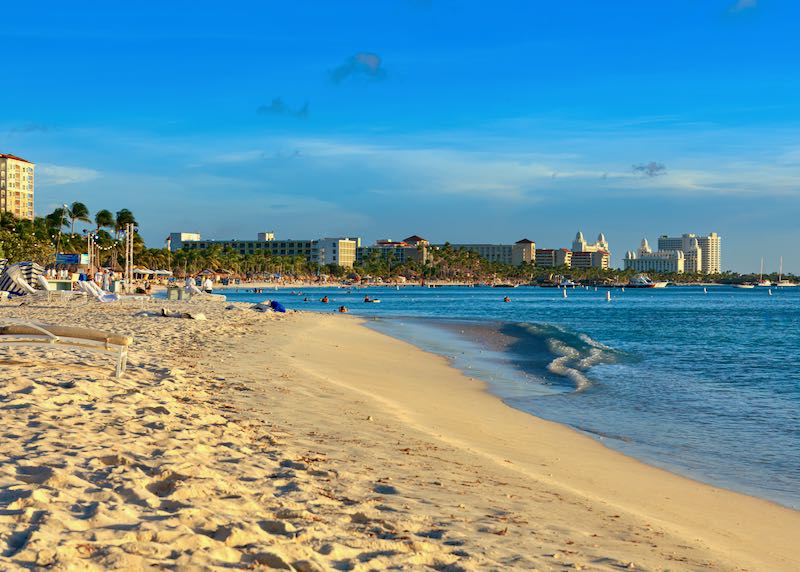Our Favorite Aruba Hotels
• 5-Star Hotel: Manchebo
• Boutique Hotel: Boardwalk
• Cheap Hotel: Kamerlingh Villa
• For Families: Hyatt Regency
• For Couples: Bucuti & Tara
• All-Inclusive: Barceló
• Best Pool: Hyatt Regency
• Near Airport: Hyatt Place Aruba Airport

The idyllic Manchebo Beach Resort & Spa on Eagle Beach in Aruba.
The Best Area to Stay in Aruba
The former Dutch colony of Aruba is the smallest but the richest and most developed of the “ABC Islands” that lie in the south Caribbean, off the north coast of Venezuela. Spain first colonized the island in the 16th century, but the Dutch captured it in 1636 (New York’s last Dutch governor, Peter Stuyvesant, was actually the first Dutch governor here). Though the Netherlands still has a say in defense and foreign policy, Aruba has been self-governing and essentially independent since 1986 (it’s officially “a constituent country within the Kingdom of the Netherlands” with Curaçao and Sint Maarten). Most islanders are descended from the original indigenous Caquetio people, formerly enslaved Africans, or Dutch settlers. The official languages are Dutch and Papiamento, a type of creole, but almost everyone you are likely to meet will speak English (and Spanish).
There’s no doubt that the main attraction here is the beach; primarily the gorgeous two-mile-long strip of white sand and palm trees known as Palm Beach, and adjoining Eagle Beach. This is where most of the hotels, restaurants, and bars are, and realistically, where you are likely to be staying – the beaches are also close to the island capital, Oranjestad, where most of the shops are located, and which retains a smattering of colonial history.
Beyond the beaches, Aruba has a surprisingly deserted hinterland, and though there’s little accommodation, it’s worth exploring San Nicolas and Santa Cruz districts for at least or day or two, to get a better sense of the island. Aruba is small – just 21 miles (33km) long by 6 miles (10km) at its widest point, but if you do decide to explore, even for a day, renting a car makes the most sense, mainly for convenience. All the major car rental companies operate on the island, and your hotel should also be able to recommend local renters. If you intend to stay on the beach and/or only visit Oranjestad you can use local buses or taxis.
Aruba Travel Tips
- Most visitors stay near a beach. The big high-rise resorts tend to cluster o nPalm Beach, while neighboring Eagle Beach is better known for smaller, low-rise hotels. The island also features numerous apartment complexes, vacation villas, and condos available to rent in lesser visited locales if you’re looking for a more tranquil experience.
- Note the taxes that will be added to your hotel bill in Aruba. There is a 9.5% government tax on rooms plus a 17% “hotel service charge” – there’s no way to avoid this. There’s also an “Environmental tax”; US$3/night for hotels.
- Aruba’s Reina Beatrix International Airport is the island’s primary international gateway, some 1.6 miles (2.5km) from the center of Oranjestad. Many hotels offer transfers, otherwise take a taxi or rent a car here. Taxis charge around US$28 to Eagle Beach and US$31 to most hotels on Palm Beach; it’s US$21 to Oranjestad.
- Arubus is the island’s public bus service. It’s most useful zipping between the beaches and Oranjestad, but to explore the island fully it’s best to rent a car. Bus fares are $2.60 per ride.
- Aruba’s Carnival period officially starts on November 11, with the first parade (the Torch Parade) held on the first Saturday in January, though like everywhere else, the main events take place in the week before Ash Wednesday (Feb/March). Book months in advance to stay on Aruba at this time.
- Incredibly, all the tap water in Aruba comes from a saltwater desalination plant – there are no natural water sources. It’s completely safe to drink it.
- Aruba’s currency is the Aruban Florin (AWG; divided into 100 cents), also known as “theAfl”, but because the US$ exchange rate is fixed (at US$1 = AWG1.79), most places will accept US dollars (albeit at US$1 to AWG1.75, with change given in florins). Other international currencies are not accepted. Credit cards are widely used and accepted everywhere.
- Aruba is very dry. February through June is the driest period, with the wettest months technically October through January, though there’s no real rainy season and the island remains relatively sunny and dry year-round. High season for hotel rates runs mid-December to mid-April.
The Best Places to Stay in Aruba

The 5-star Ritz-Carlton in Aruba.
- Best Luxury Hotels in Aruba
Marriott • Bucuti & Tara • Manchebo • Renaissance Wind Creek • Ritz-Carlton- Best Boutique Hotels in Aruba
Boardwalk • Ocean Z • RH Boutique • Wonders- Best B&Bs in Aruba
Fuego Mio • Mammaloe- Best Cheap & Midrange Hotels in Aruba
Bubali Bliss Studios • Cadushi Apartments • Costa Esmeralda Village • Juanedu Suites • Kamerlingh Villa • Pearl Aruba Condos • Tu Casita en Aruba- Best Hostels in Aruba
Hostel Room Aruba • Pista QWhere to Stay in Aruba for…
- Best Beaches: Palm Beach and Eagle Beach
If you’re aiming to stay next to a beach it’s basically a choice between Palm Beach (bigger high-rise resorts) and neighboring Eagle Beach (low rise hotels) – both are gorgeous strips of white sand on the calm west side of the island, close to the shops in Oranjestad but with plenty of eating and entertainment on site. Having said that, it is possible to snag vacation homes close to Baby Beach (in the southern district of San Nicolas), which is far less busy and wonderfully calm, or in the remote beaches in Noord District: Boca Catalina (Boca Catalina Residences is a good choice) and Arashi (see Arashi Sunsets) are small but spectacular strips of sand.- Most Romantic Destination: Eagle Beach or Santa Cruz
With sunny weather year-round, stunning sunsets, and picture-perfect beaches, Aruba is a perennially popular destination for couples, with Eagle Beach beating out the more family-friendly Palm Beach as the best place to stay – this is where you’ll find hotels with all the amenities, access to a white-sand beach, incredible sunsets, and excellent restaurants such as Así Es Mi Peru and Chalet Suisse. It’s also easy to arrange a yacht or catamaran cruise from here. For something completely different and a lot more off the beaten path, consider staying in one of the intimate guesthouses or B&Bs inland in Santa Cruz. Fuego Mio Bed & Breakfast, Mammaloe, and Santa Lucia Landhuis are all very romantic choices. From any of these guesthouses it’s a short ride to the coast, or to the attractions of Arikok National Park – tranquil sea pools and coves, hill trails, caves, and old plantation sites (unlike staying at Eagle Beach, you’ll need to rent a car staying here).• One of the most romantic, secluded spots on the island is Mangel Halto, 5 miles (8km) south of Oranjestad. It’s a tiny beach hemmed in by mangroves and offers perfect snorkeling thanks to its calm, shallow water. There are a few rental properties nearby, including the Anaté Beach Apartments and Windsong Villa.
• If you opt to stay at the Renaissance Wind Creek Resort in Oranjestad you’ll get access to the two protected beaches on private “Renaissance Island” just offshore (8 minute boat ride). Iguana Beach is for families and Flamingo Beach is adults only. The real flamingoes are an added bonus, and there are always specials for Valentine’s Day and weekly “Dinner Under the Stars”. Rent a waterside cabana for a truly romantic experience.
- Best Place for Nightlife: Palm Beach and Oranjestad
When it comes to nightlife on Aruba, you’ll likely spend most of your time in Palm Beach – most hotels have their own casinos, bars and clubs, and you can bar hop along the beach. Good choices include the Beach Bar, which has a happy hour from noon to 7pm daily; the nearby Pelican Pier Bar; the Moomba Beach Bar (between the Marriott and the Holiday Inn) that features live music and DJs; Bugaloe Beach Bar; Craft, a block inland, with its open terrace and margarita Mondays; and Gusto Nightclub for late night dancing. Palm Beach resorts are also big on shows – not quite Vegas but good fun all the same. There are carnival shows, dance shows, magic shows, dinner shows, and even a “Circus Night” at the Holiday Inn Resort Aruba.Oranjestad also features a decent spread of bars and clubs – it feels a bit less touristy here and you’ll see a few more locals. Café Chaos (L.G. Smith Blvd 60) is great for Dutch craft beers and live bands at the weekend, while Surfside Beach Bar fronts the tiny beach just south of downtown. Other good choices are the local outpost of New Orleans’ Lucy’s Retired Surfers Bar and the hip cocktails at Apotek Speakeasy.
• All major resorts in Aruba have their own casinos, generally open from noon to the early hours.
• The legal drinking age in Aruba is 18, but some clubs are over 21 only.
- Best Place for Shopping: Oranjestad
Central Oranjestad has morphed into a massive outdoor shopping mall in recent years, and though the luxury retailers, fashion boutiques, and jewelry stores are squarely aimed at cruise ship traffic, there are still bargains to be found: not just duty free perfumes, leather goods, liquor, and electronics, but also locally made handicrafts, Aruba aloe, Cuban cigars (which Americans technically cannot bring home) at Cigar Emporium in the Royal Plaza Mall, and cheap Dutch imports, such as gouda cheeses and Dutch licorice. Main Street (aka Caya G.F. Betico Croes) is the main drag, with the tramcar running up and down it – you’ll find smaller, locally owned shops here as well as major brands, plus the Aventura Mall and Holland Aruba Mall. The waterfront (Lloyd G. Smith Blvd) features larger malls: Royal Plaza Mall; Renaissance Mall, which houses Louis Vuitton, Prada, Gucci, and the like; Renaissance Marketplace; and Port of Call Market Place (L.G. Smith Blvd 17).- Safety in Aruba
Aruba is generally quite safe for tourists, though the usual precautions should be taken at night. Petty theft and street crime does occur, though rarely in tourist areas; never leave anything of value in your car or on the beach unattended. One issue that has been a problem in recent years is “skimming” at ATM machines, where criminal gangs add a device that can sneakily copy your credit card for use later, unbeknownst to you. Try to only use ATM machines inside banks, and always keep the receipt.

The wonderful Hyatt Regency Aruba Resort Spa & Casino on Palm Beach in Aruba.
The 4 Best Places in Aruba for Tourists
1. Oranjestad
The capital of Aruba, Oranjestad is a thriving port city that retains a smattering of Dutch Colonial architecture (Its nickname is “Caribbean Amsterdam” because of its colorful colonial houses), though it’s best known today as a magnet for shoppers. This is where you’ll find several malls, plus the usual spread of luxury retailers, fashion boutiques, and jewelry stores. Downtown Oranjestad is anchored by pedestrianized Main Street (aka Caya G. F. Betico Croes), where most of the shops are, though Lloyd G. Smith Boulevard along the seafront is also lined with major stores (Gucci, the Renaissance Mall, Germani Jewelers, Swarovksi, and the Royal Plaza Mall among them).
It’s not all shopping though. Historic highlights include the Museo Historico Aruba, the local history museum, which is housed in Fort Zoutman (dating back to 1798, this is easily Aruba’s oldest building). The museum also includes the Willem III Tower, added to the fort in 1868 (you can climb to the top for a birds-eye view of the city). The museum is where the “Bon Bini Festival” takes place every Tuesday from 6:30 to 8.30pm, celebrating the island’s culture with local performers, music, and dancing. History buffs should also check out the National Archaeological Museum Aruba, which holds over 10,000 Amerindian artifacts. Also in Oranjestad, the Cas di Cultura, Aruba’s national theater and cultural center, where local and international artists perform year-round. Aruba’s long history as a producer of aloe vera is commemorated at the Aruba Aloe Factory Museum and Store – the Hato Plantation here was founded in 1890.
Note also that Renaissance Island (attached to the city’s top resort, the Renaissance Wind Creek Resort) lies just off the coast near Oranjestad – it has the only private beaches on Aruba (Iguana Beach and Flamingo Beach), plus a couple of plane wreck dives and a colony of flamingoes.
• Oranjestad’s Paardenbaai (the port) is the main cruise dock on the island. The free Oranjestad Streetcar (tram) links the port with Main Street (Caya Betico Croes) as far as Plaza Nicky.
• Thanks to regular buses that zip up and down the coastal highway, Oranjestad is an easy trip from Palm Beach or Eagle Beach – you won’t have to rent a car to visit (taxis are also available).
- The Best Hotels in Oranjestad
Aruba Surfside Marina • Hotel phone: +297 583 0300
Hyatt Place Aruba Airport • Hotel phone: +297 523 1234
RH Boutique • Hotel phone: +297 585 9798
Renaissance Wind Creek • Hotel phone: +297 583 6000
Wonders • Hotel phone: +297 593 4032- Best Cheap/Midrange Hotels
Cadushi Apartments • Hotel phone: +297 593 1770
Juanedu Suites • Hotel phone: +297 735 7750
Kamerlingh Villa • Hotel phone: +297 568 1198- Best Hostels
Hostel Room Aruba • Hotel phone: +297 740 5300
Pista Q • Hotel phone: +297 594 56612. Palm Beach and Eagle Beach (Noord)
Aruba’s premier tourist districts lie some 3 miles (5km) northwest of Oranjestad, along the calm Caribbean coast. The first major strip is Eagle Beach, Aruba’s widest white sand beach and for many, its best. The hotels that line the sands here tend to be low-rise, less formal affairs than on Palm Beach, though there’s a cluster of all-inclusive resorts to the south around what’s known as Punta Brabo (such as Aruba Beach Club Resort and Divi Aruba All Inclusive Resort). Other than enjoying water sports, swimming, or just lounging on the sands, there’s not much else to see here, though right at the far northern tip of the beach stand the island’s highly photogenic fofoti trees, which twist right out of the sand (not to be confused with the island’s other national tree, the “divi divi” or watapana). A mile or so north of Eagle Beach, beyond a small headland, lies Palm Beach. This is where most of the big resorts are located, lining a gorgeous strip of sand that runs for 2 miles (3km). You’ll also find excellent restaurants and cafes, nightclubs and bars, casinos, and shops here. At the north end is a section known as “Fisherman’s Huts”, a popular spot for windsurfing and kite boarding. In between the two beaches lies the Butterfly Farm and Bubali Bird Sanctuary, a wetland preserve, both worthwhile breaks from the sun and sand.
Palm Beach, Aruba.
With more time (and preferably a rental car), it’s worth exploring the northern tip of Aruba beyond Palm Beach (simply known as “Noord”). There are a smattering of low-key resorts and hotels up here offering a quieter experience, though less choice when it comes to entertainment. There are no major beaches either, but the coast is pitted with cozy coves and small strips of sand suitable for swimming and snorkeling – secluded Boca Catalina Beach (where the wreck of German warship “Antilla” lies offshore) and Arashi Beach are especially enticing. The wild northern tip of the island is crowned by the 100ft (32m) California Lighthouse, another favorite photo spot with incredibly scenic views of the coast (and the neighboring PGA Championship golf course, Tierra del Sol Resort & Golf). Over on the wilder and rougher northeast coast, the small and remote 18th-century Alto Vista Chapel is an atmospheric spot for a hike, while nearby Philip’s Animal Garden – a bit like a petting zoo, full of rescued animals – will primarily appeal to families with kids.
• Bus L10 zips between Oranjestad and Eagle and Palm beaches if you don’t want to rent a car.
- The Best Hotels in Palm Beach and Eagle Beach (Noord)
Marriott • Hotel phone: +297 586 9000
Boardwalk • Hotel phone: +297 586 6654
Bucuti & Tara • Hotel phone: +297 583 1100
Costa Linda • Hotel phone: +297 583 8000
Hilton Caribbean • Hotel phone: +297 586 6555
Hyatt Regency • Hotel phone: +297 586 1234
Manchebo • Hotel phone: +297 582 3444
Ocean Z • Hotel phone: +297 586 9500
Playa Linda Beach Resort • Hotel phone: +297 586 1000
The Ritz-Carlton • Hotel phone: +297 527 2222- Best Cheap/Midrange Hotels
Bubali Bliss Studios • Hotel phone: +297 587 5262
Costa Esmeralda Village • Hotel phone: +297 567 5611
Pearl Aruba Condos • Hotel phone: +297 280 8777
Tu Casita en Aruba • Hotelphone: +297 568 30273. San Nicolas
San Nicolas (or Sint Nicolaas) lies 12 miles (19km) southeast along the coast from Oranjestad, offering a very different experience to the more developed tourist districts to the north. Perched at the southern tip of Aruba, this is where the island’s oil refinery industry got its start way back in the 1920s, and it’s been a primarily Afro-Aruban community since then. It’s worth a visit to learn about the district’s rich cultural traditions in the Museum of Industry (housed in the 1930s water tower), Community Museum (in the old book store), and a smattering of local art galleries along the main street (Zeppenfeldstraat). You’ll also be able to admire over 50 hand-painted murals decorating the sides of the buildings here, and visit Charlie’s Bar, a local institution since 1941. Beyond the main part of town you’ll find several lesser-visited beaches right at the southern tip of the island, the best of which is Baby Beach, with shallow waters perfect for swimming and snorkeling. On the windier eastern side of the island, Boca Grandi is another popular kite-surfing destination.
• Buses L1, L2 and L3 run from Oranjestad to San Nicolas.
• Accommodation is mostly vacation home rentals down here (near Baby Beach), but there is a cluster of quiet beach resorts further north in Savaneta, worth considering: Aruba Ocean Villas, Coral Reef Beach Apartments, and Serene by the Sea.
• San Nicolas is a great place to sample Caribbean or typical Aruban food. Saco di Felipe (on St Maarten Street) is famed for its “bag dinner”, roast meats, root vegetables and fried johnny cakes served in a brown bag and eaten with your hands. Other places to check out include O’Niel Caribbean Kitchen, Ora’s Bar and Restaurant, and Kamini’s Kitchen.
4. Santa Cruz
Much of central Aruba is encompassed within the Santa Cruz and neighboring Paradera districts. The entire eastern half is dominated by Arikok National Park, Aruba’s premier nature preserve and well worth a visit. The park covers a series of dry, scrubby hills (the highest is only 617 ft) and much of the storm-battered east coast, littered with rocky coves known as “bocas”. Highlights include the beaches of Dos Playa and Boca Prins, plus the extraordinary “Conchi” natural salt water pool, protected from the waves by a barrier of large rocks. It’s only possible to reach the pool on foot (30–40 minutes), on horseback, or via special 4×4 vehicles. The Natural Bridge near Andicuri Beach collapsed in 2007 but the beach is still one of the island’s most secluded, and good for surfing. The park’s historic and cultural attractions include petroglyphs created by the indigenous Caquetío in Fontein Cave and Quadirikiri Cave, and old plantation sites (known as “Cunucus”) such as Cunucu Arikok and Plantation Prins. Beyond the park boundary another popular activity is climbing the steps up the cone-shaped Hooiberg (“haystack” in Dutch), a small hill (540ft) offering sensational views.
Neighboring Paradera features its own roster of attractions, including the Casibari and Ayo Rock formations, huge clusters of giant boulders (Ayo also features ancient Caquetío rock drawings). Other highlights include the family-friendly Aruba Ostrich Farm and the ruins of the Bushiribana Gold Mine, set dramatically on a wild stretch of shore.
• If you’ve been to Aruba before and can do without instant beach access, consider one of the atmospheric guesthouses or B&Bs in the island’s interior for a more interesting experience. You’ll need a rental car.
- The Best Hotels in Santa Cruz
Santa Lucia Landhuis & Cunucu • Hotel phone: +297 597 7688- Best Cheap/Midrange Hotels
La Felicidad • Hotel phone: +297 564 0064
Fuego Mio Bed & Breakfast • Hotel phone: +297 567 7728
Mammaloe Bed & Breakfast • Hotel phone: +297 732 9420

About Santorini Dave